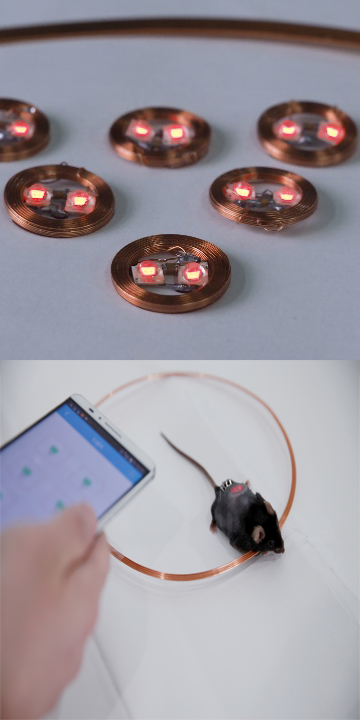
Top: Researchers optogenetically engineered cells to produce insulin or GLP-1 when triggered with far-red light, and packaged the altered cell with biocompatible LEDs. Bottom: Diabetic mouse with the packages of engineered cells and biocompatible LEDs implanted beneath the skin. The lights can be turned on or off with a smartphone, allowing remote control of the mouse's blood sugar levels. [Image: Shanghai Key Laboratory of Regulatory Biology]
Tap a smartphone screen, turn on a red LED and generate some insulin. That’s how one Chinese research team would like to simplify the future lives of diabetics.
The group, based at East China Normal University in Shanghai, recently pulled off this multidisciplinary engineering feat in tests with diabetic mice (Sci. Transl. Med., doi:10.1126/scitranslmed.aal2298). The scientists genetically engineered mammalian cells to produce hormones in the presence of far-red light, then combined the cells in a gel-like capsule with LEDs and implanted them in the mice. Based on the results of a blood-glucose test, a smartphone can be used to light up the optogenetic cells and regulate the blood sugar levels of the mice.
Mouse click
As diabetic patients know, their medications are difficult to administer automatically; after testing a blood drop with a handheld glucometer, patients must give themselves a shot of insulin or glucagon-like peptide-1 (GLP-1) drugs, depending on the type of their disease. Light-based triggering of biological processes is an ideal function to integrate with other types of electronics in a health-monitoring system.
To minimize extraneous cell damage, the East China researchers modified live cells to react to 730-nm light. Under such irradiation, the cells’ photoreceptors triggered a cascade of chemical changes within the cells, resulting in the production of either insulin or GLP-1.
In the first round of testing, the scientists simply kept the mice and their genetically engineered cells under a red phototherapy lamp. Next, they encapsulated the cells and wirelessly powered LEDs into a small blob of gel, which they called a HydrogeLED, and implanted the tiny devices into diabetic mice. Through an Android smartphone app, a bluetooth-enabled glucometer sent signals to the cell-LED devices to switch on and off (though humans could also use the app manually to adjust the brightness and exposure time). An internet-connected controller ran throughout the whole test, sending signals and power to the HydrogeLEDs through a wire loop surrounding each mouse’s environment.
Batteries required
Creating the light-controlled transgene-expression circuit was the project’s biggest challenge, according to corresponding author Haifeng Ye, a professor in the university’s Shanghai Key Laboratory of Regulatory Biology, as it took hundreds of optimization tests to develop a robust optogenetic device. Furthermore, when the team began its work, the scientists did not know how to write a smartphone app or design a circuit board, so they had to find an electronics engineer to assist them with these tasks.
Much work remains before the system can go into clinical trials, according to Ye. For example, the team needs to find compatible batteries for the gel implants, so that human patients won’t have to live inside a wire coil. At the very least, the system must be tested on larger mammals, such as dogs or monkeys, before it can be licensed for human trials in China.
